Overview of diseases and pests of clematis
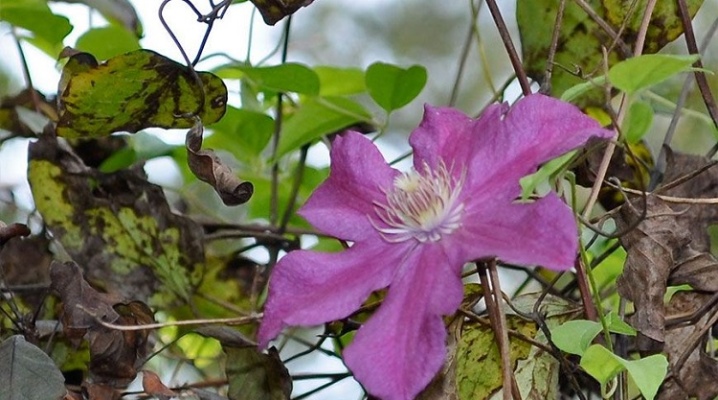
Diseases of clematis are the same as in most flowering inhabitants of the infield. Clematis is a sturdy plant with good immunity, usually able to withstand infections, and no special measures are required to protect them from infections. However, he sometimes encounters diseases and pests that damage the decorative effect of the bush and can lead to its death.
Overview of diseases
The resistance of clematis to all kinds of pathologies and attacks of garden pests is tested in the most difficult natural conditions - dry summers, cold winters, during prolonged downpours and temperature drops. Each of these phenomena creates favorable conditions for the defeat of clematis. As a rule, in the initial stages of the lesion, clematis can still be saved and the spread of infection to green pets in the neighborhood can be prevented.
In order to start resuscitation measures in a timely manner, you need to know what infections clematis most often face, and what their symptoms are.
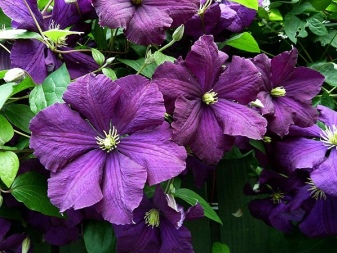
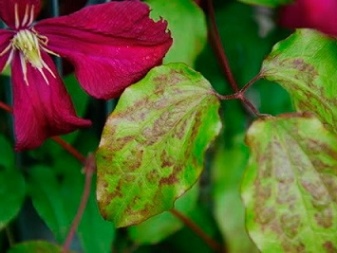
Viral diseases that cannot be treated are rather an exception for clematis, the only such pathology that clematis is faced with is a yellow mosaic, it is usually carried with ticks, caterpillars, aphids, sawflies and other insects. In such a situation, the only way out is to uproot the diseased clematis and destroy it. Attention: inexperienced gardeners often mistake the appearance of leaves with a faded color for a viral infection., most often this problem is a consequence of poor nutrition and is successfully corrected by the application of fertilizers and the normalization of the irrigation regime.
Clematis face fungal infections much more often. - As a rule, such infections cause the appearance of spots on the leaves, stems and flowers, the bush stops in development and begins to wither. If such a plant leaves in winter without appropriate treatment, it will not tolerate frost.
Ascochitosis - dark brown, brown or black spots on the leaf blades become a characteristic sign of the lesion, less often they appear at the base of the stem. The lesions most often take an oval shape, the size of the spots varies from 5 to 10 mm. Each mark has clear outlines, but as the disease progresses, it grows and merges with the rest, and holes appear in the center. In most cases, ascochitis manifests itself in the second half of summer.
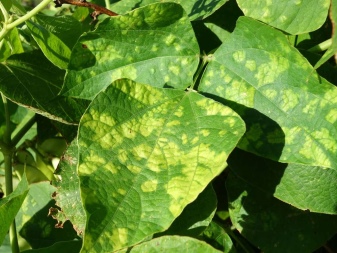
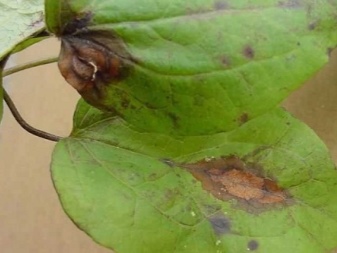
Verticillary wilting - a rather dangerous pathology, the causative agent of which is the fungus Verticillium living in the ground. Through the damaged roots, the microorganism penetrates into the vessels of the clematis, as they grow and develop, the mycelium completely clogs the lumens, which causes the plant to starve. As a result, the leaves begin to darken and the shoots dry out very quickly. Without timely started treatment, the infection progresses rapidly - in just one day, several rather large shoots can die off at once. Therefore, you need to start treatment as soon as possible, otherwise in a matter of days you can completely lose your blooming pet.
Phomopsis wilt - this pathology begins to manifest itself in May-June. Then, on the lower petals located near the ground, single spots of a reddish-brown or yellowish color appear. Diseased leaves dry out quickly, later the disease can be found on the petals of blossoming buds.This fungus is most dangerous for cultivated hybrids. If treatment is not carried out, then the entire aerial part of clematis dies completely, while simple, non-selective varieties can grow and develop, even despite the infection.
Rust - this specific disease makes itself felt in the spring, when small swellings appear on the leaf plates and stems, covered with a reddish bloom. The affected areas quickly turn brown, curl and wither. This disease is highly contagious - flying spores of the fungus are carried by the wind and infect all nearby plants.
To a large extent, the spread of rust is facilitated by weeds, especially wheatgrass - spores of the causative agent of the disease often hibernate on them, therefore all weeds must be regularly uprooted.
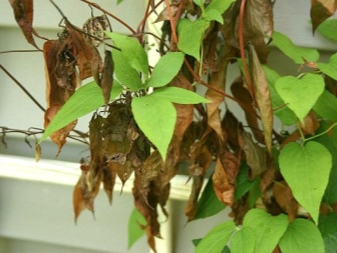
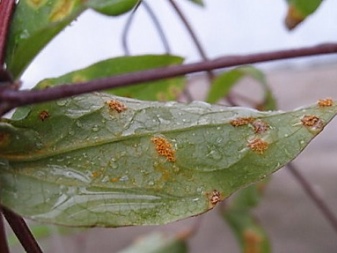
Gray rot - a disease familiar to many gardeners, which often affects clematis during rainy periods, as well as in poor lighting and insufficient ventilation of clematis bushes. The characteristic signs of the fungus are brownish spots on leaf plates and flowers, covered with a grayish edge. In the absence of treatment, young shoots and foliage die off very quickly, the vine stops growing, stops blooming and begins to wither. Gray rot gives off spores that are carried by the wind and cause infection not only of flowering plants, but also of most garden crops. All damaged plants must be treated at the same time.
Powdery mildew - as the name implies, the diseased clematis looks as if it is sprinkled with flour, and everything from flowers to the main stems, this ailment can damage even the seeds. As microorganisms develop, the plaque takes on a brown hue, the damaged parts of clematis are deformed, and flowering stops. Most often, powdery mildew affects plants in the south during the peak of the hottest months.
Wilt - another pathology that begins with the dying off of the apical shoots. If you look closely, you can see the accumulation of black dots, in them the maturation of spores occurs, which penetrate into the vessels of clematis and clog their permeability for moisture and nutrients.
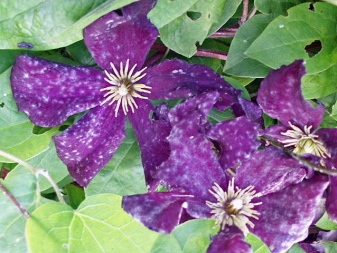
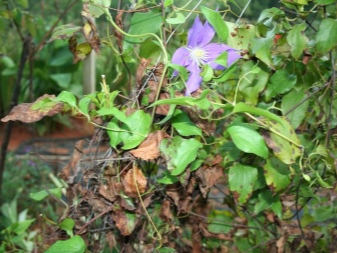
Description of pests
The roots of clematis and its aerial parts contain bitterness and even toxic substances, which is why this plant is not of interest for caterpillars and the vast majority of insects. Nevertheless, there are pests that this does not stop - they can cause quite significant damage to the vines.
Medvedki - fairly large insects that live in the soil. These pests dig holes in the ground and destroy the root system of young clematis. Medvedka is able to completely plow a garden bed with freshly planted clematis and thereby destroy the seedlings. For adult plants, the insect is not so dangerous, since the roots by this time become stronger and longer, however, through the damaged areas the plant "opens" for the penetration of other pathogenic microflora. It is not easy to get rid of the bear, some gardeners use folk methods to combat this pest - they pour a concentrated solution of laundry soap into the passages, and also treat insects with special preparations, for example, Metarizin. The disadvantage of this method is the need to track insects that get out.
Nematodes - these are small worms. They parasitize on the root system of clematis and have the ability to move inside the stems, climbing to the leaves and flowers. All this creates an obstacle to the full breathing of green parts and their nutrition, which quickly causes their death. Affected bushes become lethargic, faded and depressed, lagging behind in development.
Young clematodes affected by nematodes do not develop and quickly die, adult plants retain their decorative effect when affected by nematodes, with a sufficient amount of fertilizer, a perennial bush can bloom even when infected.
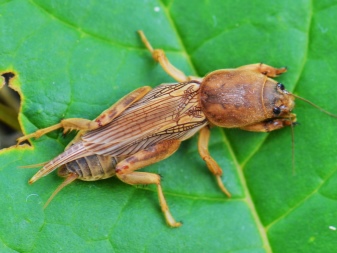
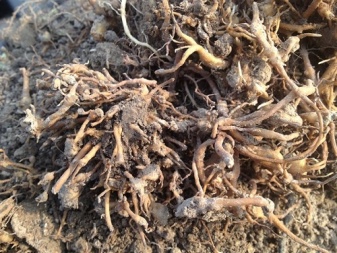
There is currently no absolutely effective method of treating plants affected by nematodes, therefore special attention must be paid to prevention - carefully inspect purchased seedlings immediately before planting, be sure to disinfect the planting hole with hot water heated to +50 degrees Celsius or more. It is also believed that mulching the soil with bitter wormwood and peppermint can scare away nematodes. Damaged parts of the bush cannot be treated - they must be removed and burned. In areas from which diseased clematis were uprooted, nothing should be planted for at least 3-4 years.
Spider mite - this is a very small insect, its size is so insignificant that one can judge the defeat only by the appearance of a whitish cobweb on leaf plates and green shoots. In the early stages of the lesion, yellowish spots appear on the lower part of the leaf plate, such leaves quickly lose their color and dry out.
Most often, the spread of spider mites is facilitated by dry weather, because the mite fully makes itself felt in mid-July. It is very difficult to get rid of the problem - the affected leaves and stems hardly respond to treatment, although spraying with Actellik is somewhat effective. Spraying with systemic insecticides is repeated 3-4 times per season, some gardeners are trying to fight the scourge with biological agents, for example, soapy water or tincture of garlic. In the case of a spider mite, these measures do not give any result; their use is allowed only as prevention of damage.
Slugs and snails - these same pests are capable of attacking clematis at any time from early spring to autumn, causing significant damage to the plant. Several slugs can completely destroy the buds on young shoots, which leads to the suspension of the growth of the entire bush, and the damage left by pests on the bushes most often becomes an "entrance" for pathogenic microflora.
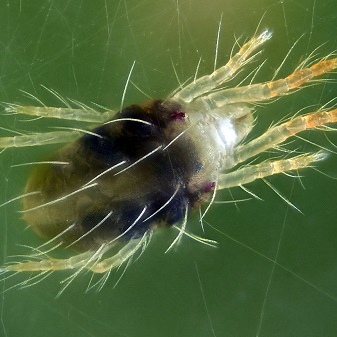
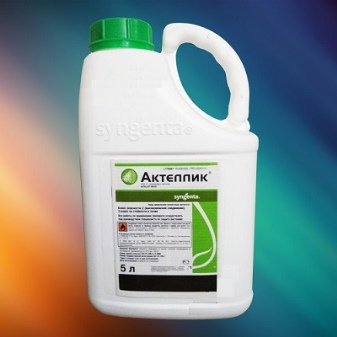
In order to prevent damage from slugs, it is necessary to keep the ground around the bushes in a clean, always loose state - these pests usually live on large leaves of weeds. As a preventive measure, sprinkling the earth with ash, salt or lime is used. However, these measures can scare off slugs, if the invasion has already begun, it will not be possible to stop it this way. Usually, Ferramol and Metaldehyde are used for the treatment of slug plantings; they are scattered on the ground in a proportion of 40 g for each square meter of plantings.
Aphid - a small insect no more than 2 mm long. Despite its small size, the pest can cause significant damage to both young and old clematis. The fact is that clematis often become a wintering place for eggs laid by aphids; therefore, with the arrival of spring heat, young individuals hatch from them and begin to parasitize on powerful green shoots, sucking out all vital juices from them.
You can identify aphids by the shiny, sticky bloom that it leaves behind. These insects are especially active in the first half of June, when wings form in an adult. It is extremely important to determine the defeat even before the pest learns to move independently and equip its colonies on top of young shoots. At this stage, they can still be removed physically by rinsing with water from a hose, followed by treatment with soapy water.
In the later stages of the lesion, more severe chemicals are required.
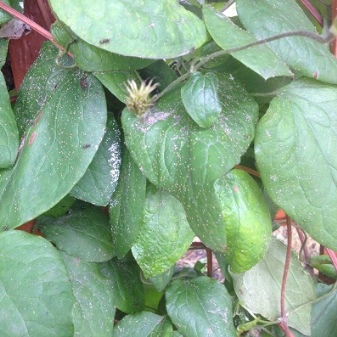
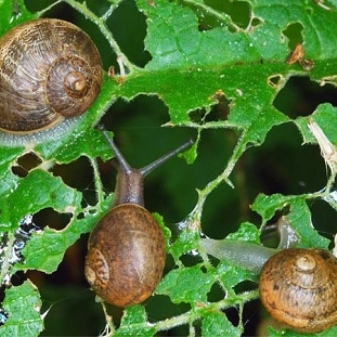
Treatment methods
In the very early stages of pest infestation, physical cleansing measures can be used - collecting snails and slugs with your hands or brushing off aphids with water, such measures will prevent the spread of the disease and minimize the need to treat the bushes with complex chemicals.
If there are too many pests, store-bought insecticides will be required for resuscitation. Such funds can quickly revive the plant, but they are very poisonous, they must be selected in strict accordance with the type of clematis lesion. The compositions are highly effective, but at the same time they can cause significant harm to all horticultural crops, therefore, treatment with the use of such drugs should be dosed and limited.
In case of moderate damage, it is better to give preference to biological compounds: Vermittek, Fitoverm and Bitoxybacillin are most effective - treatment with these solutions provides not only therapy for the diseased bush, but also protects against subsequent infection for 2 weeks.
The safest are compositions based on plant raw materials, usually the following components are used for them:
- onions, garlic, as well as their husks;
- dry mustard powder - it is diluted at the rate of 10 g per 1 liter of water;
- tobacco dust - 40 g per 1 liter of water;
- poisonous herbs such as datura, belladonna and henbane.


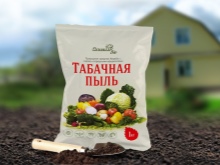
To combat aphids, experienced gardeners recommend treating the bush with a solution of potash soap, as well as infusion of wormwood and celandine.
Slugs and snails can be destroyed with salt or ammonia, and special traps are usually used against the bear. The decision to use a particular drug depends on the size of the lesion and the stage of the disease.
Diseases of clematis are treated a little differently. Since most of them are fungal in nature, in most cases, treatment can be reduced to three-fold treatment with any copper-containing preparation, for example, copper sulfate. Diseased areas of clematis must be removed and burned. Keep in mind that they should not be used for subsequent mulching and composting.
A 0.2% solution of "Fundazol" is highly effective against all types of damage - it is treated with the root zone for three days in a row. Such drugs as "Azocene" and "Topaz" cope well with the causative agents of fungal diseases.
To protect garden plants from diseases and strengthen immunity, you can use a new generation of biological remedies:
- Alirin-B;
- "Gamair";
- "Baktofit";
- Fitosporin
- "Pure color".
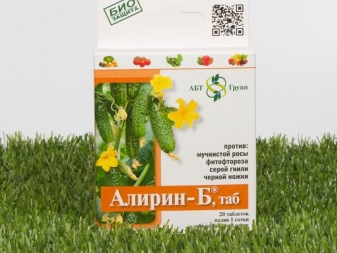
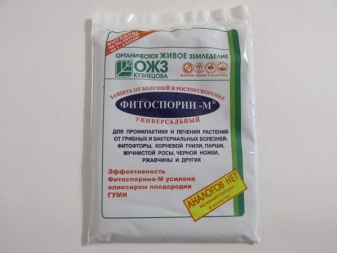
Preventive measures
As you know, the disease is easier to prevent than to cure. And in the case of clematis disease, this rule works 100%. Competent spring care helps to increase the resistance of clematis and effectively prevents the infection of the bushes by overwintered insects.
Agricultural rules are standard here.
- The entire winter layer of mulch must be removed. It most often contains eggs of insects, parasites, and fungal spores.
- Any spring dressing must be accompanied by foliar spraying. For this, the fertilizer is diluted in a double volume of water.
- A universal method that protects clematis from damage by insects and diseases is the treatment with Bordeaux liquid. It is produced in the spring: the soil is irrigated every 2 weeks, and the green parts are sprayed until the beginning of bud formation.
- Application of nitrogen-based fertilizers to the soil in early spring can enrich the soil and stimulate the growth of clematis. Such dressings need to be done 2 times a month, timely replacing them with phosphorus and potassium - a healthy and strong plant gains the ability to resist infections.
- It is very important to regularly inspect the green parts and flowers of clematis for the appearance of pests and the first signs of fungal infection.


However, pest prevention does not end with spring processing. Throughout the growing season, the soil must be kept loose, weeds must be removed and the soil mulched. The plant needs a sufficient level of moisture - the roots of clematis lie 1 m in the ground, so watering should be quite abundant. So, an adult bush needs up to 4 buckets of water at a time. At the same time, stagnation of moisture in the ground should not be allowed - in rainy and cloudy weather, it is necessary to immediately prevent fungal infections.
In conclusion, we will dwell on the problems of clematis, which are of a physiological nature - that is, their causes are in no way related to the activity of garden pests and pathogenic microflora. Many diseases are associated with mistakes in care - improper moisture regime, lack of certain minerals, poor control of the soil composition. Thus, partial clarification of leaves and flowers is most often the result of insufficient lighting, prolonged temperature drop or nitrogen deficiency in the soil.
Reddening of the stems is usually observed during hot and dry periods. If the flowers and the edges of the leaves have changed their shade to brown, while the buds have dried up without blooming, this directly indicates a lack of potassium. But the shortened internodes, a decrease in the growth rate of shoots, on the contrary, indicate its excess.
Calcium deficiency will be indicated by slowed root growth, as well as softening of the stems.
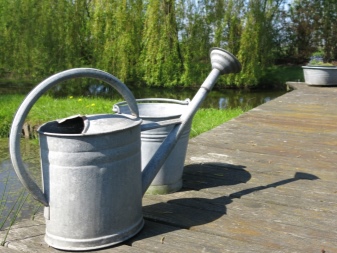
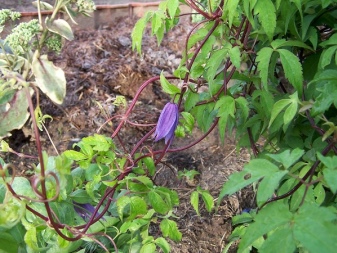
With a lack of magnesium, the roots become fibrous, and with a deficiency, the young leaves turn yellow. Chlorosis of the leaves starting from the top, accompanied by an abnormally whitish color of the flowers, indicates that the plant requires iron. If there is too much iron in the soil, the bush stops growing, and internodes are shortened.
Any of these problems is solved by making the necessary dressings and does not entail the death of clematis.
In the next video, you will find an overview of clematis diseases and pests.







































































































The comment was sent successfully.